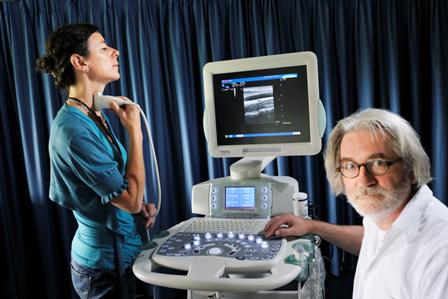Ultrasound scanner measures blood pressure from many points in body
4 July 2011
Researchers at Eindhoven University of Technology, together with Italian company Esaote, have developed a new technique to measure blood pressure using ultrasound.
Using an ultrasound scanner, which is well known from pregnancy ultrasound scans, they will soon be able to measure the blood pressure pulse at many points in the body. The ultrasound scan can show blood flow and the blood vessel wall motion, from which the blood pressure can be derived using a mathematical model. This will provide much more information about the vascular system than the traditional measurement method using an inflatable cuff on the arm.
As a result, physicians will be able in the future to quickly gain an overall impression of the condition of the heart and blood vessels. This is in line with the current trend in healthcare with an increasing focus on the prevention of cardiovascular disease. The results were published last month in the journal Ultrasound in Medicine and Biology.
“Scientists have for years been looking for a non-invasive method to measure the blood pressure pulses at highly localized points in the body”, explains TU/e researcher dr. Nathalie Bijnens of the Department of Biomedical Engineering.
“The usual method is to insert a catheter with a pressure sensor. But that’s an invasive procedure, and not suitable for preventive diagnostics. There’s also the traditional method using an inflatable arm cuff. But that doesn’t allow any conclusions to be drawn about — for example — the blood pressure in the carotid artery. In this method, the cuff is inflated until the blood flow in the arm is stopped, allowing the systolic and diastolic (maximum and minimum) values in the arm to be measured. That means you won’t find anyone willing to have the blood pressure in their neck measured using an inflatable cuff.”

Nathalie Bijnens and Frans van de Vosse of
Eindhoven University of Technology (TU/e) presenting their new blood
pressure measurement technique.
Photo: Bart van Overbeeke.
Atherosclerosis
The new technique uses ultrasound to make patient-friendly blood pressure measurements at many points in the body. All that is needed is to apply a small amount of gel so that the ultrasound scanner makes good contact with the skin.
The key to the new technique is above all the sophisticated signal processing. The researchers are able to achieve good visualization of the blood flow and the blood vessel wall motion, from which the blood pressure can be derived, by means of a mathematical model.
They can also see the variations in blood pressure and flow in time as a result of the beating of the heart. The simultaneous knowledge of pressure and flow also provides information about ‘downstream’ parts of the vascular system. The new technique will allow physicians to carry out preventive investigations of the cardiovascular system, for example, and to monitor the development of diseases such as atherosclerosis, thrombosos or aneurysms (dangerous dilations of a blood vessel).
Preventive scanning
The researchers published their results last month in the scientific journal Ultrasound in Medicine and Biology. The method was first tested on elastic plastic tubes, and after that on pigs’ carotid arteries from an abattoir, with good results. The technique is currently being tested on volunteers, in advance of clinical tests with patients.
The results are promising. It is still expected to take several years before the technique can be used in clinical practice, for example in family doctors’ surgeries, says Bijnens. “By performing a simple scan, the physician can detect vascular disease in an early stage and decide for a preventive treatment.”
New direction
This new method for measuring blood pressure is part of a new direction for the research group led by prof. Frans van de Vosse. The group’s work focuses on making mathematical models of the vascular system. “For example we have developed a model to locate the best places to enter veins in the arms of dialysis patients”, says Van de Vosse. “But that model needs detailled input, which is why we decided to develop a measurement method ourselves.”
Further information
Toward Noninvasive Blood Pressure Assessment in Arteries by Using Ultrasound. Ultrasound in Medicine and Biology, May 2011. DOI: 10.1016/j.ultrasmedbio.2011.01.020.